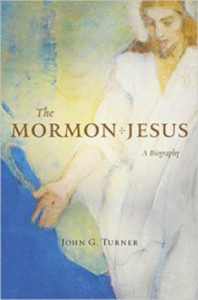In the preceding post (part 1), I work through a set of exegetical preliminaries to any theological engagement with D&C 25, the revelation to Emma Smith. I take as my task now to begin addressing the revelation at that more interpretive level. I’ll give my attention to three isolable themes in particular in the course of this post, each with clear implications for feminist interests.
First, I want to look at the universalizing gestures that appeared in the original (1830) version of the revelation, as well as those that were subsequently worked into the revelation editorially (especially for the 1835 version). Second, I want to look at the relationship between, on the one hand, verse 4 and, on the other, verses 5-12—at how, that is, the several appointments given to Emma in the course of the revelation seem to have their motivation in the Lord’s explicit recognition of Emma’s marginalized status. Finally, I want to look at the larger scriptural resonances of the several appointments given to Emma, most particularly those through which she was apparently set to take over work that had been Oliver Cowdery’s.
Though I’ll be looking at three isolable themes, I think it’s best to see them as connecting up with each other in important ways. In order to bring this out, I’ll conclude the respective discussions of the first two themes by raising questions that can be said to be addressed, at least indirectly, by the discussion of the third theme. I want thus to suggest that there is something in the discussion of the second theme that begins to address the questions I raise about the first theme, as well as something in the discussion of the third theme that begins to address the questions I raise about the second theme. The third theme will have to speak for itself.
De-Gendering a Revelation
The original (1830) version of what is now D&C 25 concludes with what appears to be a universalizing gesture: “And verily, verily, I say unto you, that this is my voice unto all.” This final note of sorts is perhaps a bit strange, since most everything else in the original version of the revelation is quite particular, addressed to a particular woman (Emma Smith) and her very particular circumstances. There are, of course, some other minimal gestures toward more general concerns—most obviously what is now verse 12, with its general comment on “the song of the heart” (the verse that remains the most quoted and commented on part of this revelation, even being “privileged” as a scripture mastery scripture in the seminary program). But, at least as originally dictated, this revelation is generally local, particular, specific, without (obvious) universal implications. One would have had to do a fair bit of “likening,” as Latter-day Saints call it, to draw general consequences.
In the end, moreover, it might be too strong an interpretive move to take the “voice unto all” of verse 16 to be an indication that the revelation is meant to have universal implications. Indeed, it may be best to see verse 16 as explaining the shift from “thou” to “you” at the end of verse 15 (“And except thou [singular] do this, where I am you [plural] cannot come”). Indeed, I think this may be the best explanation, given the fact that the earliest manuscript of this revelation reveals that there was some confusion about this from-thou-to-you switch (the scribe, John Whitmer, originally wrote “thou,” wipe-erased it and wrote “ye” over it; Sidney Ridgon later crossed “ye” out and wrote “thou” above the line; and after all this it ended up as “you” in the 1833 and 1835 versions of the text). It thus might be best, exegetically, to take the “voice unto all” not to be the revelation as a whole, but only what is now found in verse 15: “Keep my commandments continually, and a crown of righteousness thou shalt receive. And except thou do this, where I am you cannot come.”
But even if the original version of the revelation thus seems not really to have any strong gestures toward universalization, editorial work on the revelation between 1830 and 1835 produced a few such gestures, and much stronger ones at that. In my previous post I mentioned the fact that what was originally simply “Emma, my daughter in Zion, a revelation I give unto you concerning my will” became by 1835 the whole of what is now verses 1-2. Significantly, those two verses include several universalizing traits. Note, for instance, the expansion of “my daughter”: “Emma Smith, my daughter; for verily I say unto you, all those who receive my gospel are sons and daughters in my kingdom” (verse 1). There is a clear shift here from the particular (“Emma, my daughter”) to the universal (“all those who receive my gospel are sons and daughters in my kingdom”). And, significantly, what had originally been exclusively gendered female (“my daughter”) becomes either de-gendered or both-gendered (“sons and daughters in my kingdom”).
It seems clear to me, moreover, that these editorial alterations were in part made with an eye to the apparent universalizing gesture of verse 16. Slipped in between “Emma Smith, my daughter” and “all those who receive my gospel are sons and daughters in my kingdom” is a phrase drawn, it seems clear, directly from verse 16: “verily I say unto you.” It is that phrase that introduces the “voice unto all” of verse 16 specifically. Other aspects of what is now verses 1-2 draw clearly on at least the spirit of verses 13-16 more generally, connecting up the initial address or introduction with the conclusion and its at least mildly universalizing spirit. At least one commentator—a woman, significantly—has noted the interpretive importance of verse 16:
[The revelation] concludes with these significant words, which Joseph Smith repeated years later to the Relief Society in reference to the revelation: “And this is my word unto all.” Thus, in significant ways, it transcends the merely personal, fitting the parameters of scripture and thereby acquiring permanence, authority, and universality. While its specifics are addressed to Emma, its principles are applicable to all. (See Madsen, “The ‘Elect Lady’ Revelation,” p. 120.)
Another such gesture deserves at least to be mentioned. In the preceding post, I provided some details concerning a minute change with enormous interpretive implications made, between 1833 and 1835, to verse 9 (“support thee from the church” becomes “support thee in the church”). I think it well worth noting that there is a universalizing aspect to this alteration as well. While few readers of this revelation could identify with Emma’s particular concerns about Joseph’s doomedness-to-poverty, many readers can identify with concerns (attributed, unfairly I think, to Emma by the editor) about inadequacies in fulfilling divinely appointed responsibilities. Most people faced with a divine appointment, at any rate, experience some sort of “fear” and hope for some sort of “support.” I don’t deny that there are unfortunate side effects of this change, as I discussed in my last post, but I think its gesture of universalization is of real theological significance, regardless of its other effects.
So, why this emphasis on universalization? I’m inclined to believe that it’s largely motivated by the aims of the 1835 publication in which these editorial changes first appeared. Earlier efforts at publishing Joseph’s revelations involved little editing. The revelations were left more or less as they were originally dictated, and the weight of their historical importance was given to be felt. This was especially true in the 1833, never-quite-finished Book of Commandments, in which Emma’s revelation first appeared. The revelations were there ordered chronologically, collectively demonstrating exactly what the preface to the volume said they were meant to do (see what is now D&C 1:24-28). But when plans were made to produce the (first edition of the) Doctrine and Covenants, issued in 1835, the idea behind publishing the revelations changed drastically. (I’ve written a lengthy piece about this issue elsewhere.) The 1835 volume was meant to be less a chronicle of the Lord’s communications to the Saints than an early version of what is now the Handbook of Instructions. The revelations were thus de-chronologized and ordered according to institutional importance, with revelations concerning the priesthood and the establishment of Zion being particularly privileged and non-revelatory material (the Lectures on Faith, official statements of belief, etc.) included in the volume. The heavy editing to which many of the revelations were subjected was clearly aimed at fitting them into this institutional context.
What is now D&C 25 was among those edited for inclusion. Thus, this general gesture in the direction of the universal—the will to make all of the revelations of general benefit and not just of historical interest, despite their having been received in very particular settings and with very particular original aims and intentions—seems to have been largely behind most of the changes to D&C 25. But all this raises an important question. What might be said, theologically, about altering the historically accurate wording of a revelation in order to give it more universal appeal or applicability? What could justify such a move? More specifically in terms of D&C 25 and more relevant to current concerns: What could justify such a move when it de-genders (or at least begins to de-gender) the only revelation given to a woman in the whole Doctrine and Covenants? Do these changes not amount to (the beginnings of) an erasing of woman from the canonized revelations? And might one not suggest that the fact that it is undertaken in connection with the institutionalization of the Church and the associated centralization of an exclusively male priesthood means that the “universal” being appealed to is less genderless than male-gendered?
Perhaps these several questions can be focused into a single interpretive question, theologically posed: What is to be said about the introduction of “sons” into a revelation that originally addressed only a “daughter”?
I won’t answer this question here, though I do believe that the discussion of the next theme I’d like to consider provides the beginnings of a response to it.
Moving Out of the Margins
In part 1, I mentioned the unfortunate fact that a certain reading of verse 4 has played a dominating role in the interpretation of this revelation. Taking the Lord’s injunction to “murmur not” as a clear indication that Emma was murmuring, commentators—all male—have generally taken this revelation as a proof that Emma was doing a fair bit of whining about not having seen the gold plates, expressing a wrongly inspired sense of entitlement as the wife of the prophet. Emma’s (female) biographers summarize this sad history of interpretation: “That single line urging Emma to ‘murmur not’ would later give rise to speculation that Emma had complained of not seeing the record. Future writers would use that phrase to condemn Emma, but nothing in the Elect Lady revelation approaches the chastisements Joseph occasionally received.” (See Newell and Avery, Mormon Enigma, p. 33.) To quote just one example of such interpretation: “The inference from this revelation is that Emma was a proud, fearful, murmuring woman, and later events corroborated this analysis to a large extent.” (See Gibbons, Joseph Smith, p. 90.)
As I said in part 1, most everything is wrong about such interpretations—especially when they go on to suggest that the Lord’s response to such desires is basically to tell Emma to be, and I’ll quote another commentator here, “obedient to her husband.” (See Smith, Church History and Modern Doctrine, p. 1:117. Note, significantly, that the revelation never speaks of obedience to Joseph, only of being “a comfort” for him, serving as his scribe, being ordained by him, being supported by him from the Church, and “delight[ing]” in him. There is never a word to Emma about being obedient to her husband.) All the same, there is at least one (and very likely only one) thing right about such approaches to the revelation: they rightly recognize that the Lord’s injunction not to murmur is key to interpreting the text. The unfortunate thing is that, due to whatever sources of blindness, none of these commentators reads very carefully, at least in handling this particular revelation.
Newell and Avery, it seems to me, note the important point in the snippet I quoted from them just above: every conclusion drawn that “Emma had complained of not seeing the record” is ultimately a “speculation.” The Lord doesn’t say to Emma that she had murmured and so done wrong, that she has murmuring to repent of. Rather, the Lord simply tells her not to murmur. All that is implied here, strictly speaking, is that Emma faced a real—and, frankly, obvious—temptation. She would unquestionably have been tempted to murmur. But the crucial question is: Tempted to murmur because of what? Because, as the Lord puts it, of her marginalized status: “Murmur not because of the things which thou hast not seen.” Emma has, despite her unfailing support for Joseph, been left out of things, and the revelation attributes to the Lord an explicit recognition of the fact. It’s crucial to see that it’s in direct response to this recognition on the Lord’s part—to this recognition of Emma’s marginal or marginalized status—that certain appointments and responsibilities are given to her. This revelation thus serves as a kind of call to Emma to move out of the margins, assuming responsibilities that have hitherto been entirely the work of men, as I’ll explain below.
Verse 4 is thus, I want to suggest, indeed the key to understanding the revelation. But it isn’t the key in the sense traditionally assumed. It doesn’t give us to see that Emma was a “proud, fearful, murmuring woman.” It gives us rather to see that she faced a real—and perhaps unavoidable—temptation to wallow in self-pity, to sulk on the margins, if not to use her marginalization as an excuse not to have to take up any serious responsibilities. The Lord cautioned her against such self-congratulatory murmuring, inviting her instead to move out of the margins and into the beating heart of the Church, appointing her to a remarkable position in the young movement.
Interestingly, this gesture is accompanied by a kind of apology right in verse 4. What Emma had not seen had been “withheld from [her] and from the world” because it was “wisdom in [the Lord] in a time to come.” That any kind of explanation was seen as called for is remarkable. The Lord himself feels to justify not having given Emma a position of central responsibility any sooner—but explains that this was “wisdom . . . in a time to come.” That gesture deserves the closest theological scrutiny, and I suspect that it could bear delicious fruit. When is the “time” that was then still “to come” when Emma’s passing marginalization, imposed but then removed quite fully, would serve God’s wisest purposes? That, it seems to me, is a question well worth pursuing.
But the theological question I want to raise more directly here concerns the invitation to move out of the margins. How might we think about this revelatory gesture—this explicit divine recognition of the marginalized status of this woman at the beginnings of the history of the Church, and this direct bestowal on that woman of responsibilities that clearly mean to bring her to a privileged position of authority?
Yet again, I don’t want to answer this question directly. But yet again, I think the discussion of the next—and last—theme I’ll be addressing will open up the beginnings of a response to this question.
Serving as Scribe, Expounding Scripture
D&C 25:5-12 details three responsibilities given to Emma in order to bring her out of the margins of early Mormonism. I want to give this series of appointments a very strong reading, one that I think is entirely borne out by the texts themselves. I’ll argue, in effect, that Emma was—originally, at least—asked to take the place of Oliver Cowdery in the budding movement. To make this case, it’s necessary to provide a bit of background about the role Oliver played in the Restoration more generally.
Anyone familiar with early Mormon history will be familiar with Oliver’s basic story. He wandered into the Restoration when he began boarding with Joseph Smith’s family over the winter of 1828-29. In April, he made his way from New York to Pennsylvania to meet the prophet, and he immediately assumed the task of taking down Joseph’s dictation of the Book of Mormon. From that point, Oliver became a central figure in the Restoration. Only a month after he met Joseph, he would join him on the banks of the Susquehanna River to receive the Aaronic priesthood at the hands of John the Baptist. Sometime later—most likely, interestingly, only weeks before Emma’s revelation was given—Oliver was with Joseph in the woods when Peter, James, and John appeared to give them the keys of what would come to be known as the Melchizedek priesthood. In connection with these events, Oliver was given the divinely appointed task to write what might be called the “constitution” of the Church—although what Oliver put together would be replaced with a direct revelation to Joseph Smith, what is now D&C 20. Oliver was also privileged to be one of the three witnesses who saw an angel bearing the gold plates themselves.
So much early privilege. But matters became strained between Joseph and Oliver in the months following the April 1830 organization of the Church. Oliver fell in with Hiram Page and the revelations he claimed to be receiving through his own seer stone. He also wrote Joseph a rather highhanded letter criticizing him for his handling of the revelations that had been legitimately received. By the time Emma’s revelation was given, things were tense between Joseph and Oliver. Several revelations from the summer of 1830 suggest that the Lord was beginning to move Oliver out of the central position he had held to that point—that of the “second elder” in the Church of Christ—thus freeing up the most privileged office in the Church next to the “Seer, Translator, Prophet, Apostle of Jesus Christ, and Elder of the Church” that Joseph was (see D&C 21:1). By the fall of 1830, Oliver would be sent away from the Church’s eastern headquarters to serve a mission among “the Lamanites” in the West.
Oliver eventually came back into favor (though only after other tensions and a brief period of excommunication), favor enough to take the lead in searching out and ordaining the members of the 1835 Quorum of Twelve Apostles, as well as to stand next to Joseph in 1836 when the next set of priesthood keys were granted in the newly dedicated Kirtland House of the Lord (see D&C 110). But shortly thereafter, Oliver reinvented his earlier struggles against Joseph’s authority and found himself excommunicated by 1838, not to be rebaptized until after Joseph’s death. At that later point, when Oliver’s privileged position as “second elder” was again—and more definitively—vacated, it would be Hyrum Smith who would assume it (see D&C 124:91-96), eventually being the one to stand at Joseph’s side in martyrdom (see D&C 135:6).
But coming back to 1830: Who assumed Oliver’s central position when the Lord moved him from the center to the margins? According to D&C 25, it was to be Emma. This is clearly the implication of verse 6 in the original (1830) version: “And thou shalt go with him [Joseph] at the time of his going [to the churches in Fayette, Manchester, and Colesville], and be unto him for a scribe, that I may send Oliver whithersoever I will.” Emma was to be Joseph’s new scribe, as well as to take over the other responsibilities Oliver had had, according to verses 7-8: “And thou shalt be ordained under his [Joseph’s] hand to expound scriptures, and to exhort the church, according as it shall be given thee by my Spirit. . . . And thy time shall be given to writing, and to learning much.” All of these things had been Oliver’s work. It seems clear that Emma was being brought in from the margins not just to assume a token position, but the most central position next to Joseph. She was being appointed to assume the role outlined, according to the Book of Mormon, more than three millennia before Emma’s revelation was given: “And the Lord said unto me [Joseph of Egypt] also: I will raise up unto the fruit of thy loins; and I will make for him a spokesman. And I, behold, I will give unto him that he shall write the writing of the fruit of thy loins, unto the fruit of thy loins; and the spokesman of thy loins shall declare it” (2 Nephi 3:18).
Unfortunately, it seems that Emma didn’t really actually assume the assigned responsibilities in 1830—at least not in any permanent fashion. This may be because she was—as she soon found out—in the beginnings of a difficult pregnancy (twins that would both die). It may be because Oliver didn’t end up leaving for some time, giving him an opportunity to sort out some of the tensions between him and Joseph (see, for instance, D&C 28). It may be because Sidney Rigdon arrived as a kind of celebrity convert in December and immediately took over Oliver’s work, leaving Emma yet again at the margins of the movement. It may be that escalating persecution, which would quickly lead the whole body of eastern Saints to migrate to Ohio, interrupted the day-to-day affairs of the Church enough that it was easier for Joseph to let Emma slip back into the margins while waiting to see what the body of converts in Ohio looked like.
Whatever the reasons, Emma didn’t really become Joseph’s scribe, nor did she become his spokesman. And one of the consequences of this unfortunate history is that, in the preparation of the 1835 Doctrine and Covenants, verse 6 was edited to conform to the history as it had actually happened. As I discussed in part 1, Emma’s appointment was downplayed with the addition of the phrase “while there is no one to be a scribe for him” to the phrase “and be unto him for a scribe.” (The words “my servant” were also slipped in before Oliver’s name, perhaps reflecting the fact that Oliver had again become a central and privileged figure in the Church by 1835. He was, interestingly, in charge of publishing the 1835 Doctrine and Covenants, and he may well have been the one who made the edits to this revelation!) These changes, once canonized, would have interesting effects on the employment of the revelation in the founding of the Relief Society in Nauvoo. That’s a question, though, to be addressed on another occasion.
From this sad history, it would seem that Emma’s revelation ultimately failed to have the effect that, according to the original, the Lord desired. Rather than bringing her out of the margins and into the heart of the Church, it gave her a somewhat complex position in an edited, canonical revelation, little more.
But this sad history would be, it seems, radically reversed—at least in important respects—in Nauvoo. On March 17, 1842, the Relief Society would be organized, and D&C 25 would serve as its founding document. From the minutes of that organizing event: “President Smith read the Revelation to Emma Smith, from the book of Doctrine and Covenants; and stated that she was ordain’d at the time, the Revelation was given, to expound the scriptures to all; and to teach the female part of community; and that not she alone, but others, may attain to the same blessings.” But was this anything like the assumption of a position like that once held by Oliver? I think so. It is clear, at any rate, from the minutes of the earliest meetings of the Relief Society that Joseph intended that organization to be the female counterpart to the male priesthood, and that Emma was its president as Joseph was the president of the male parallel—and it seems clear that the Relief Society was in part meant to prepare women to officiate in the completed Nauvoo temple. Joseph thus said that he wanted Emma and her counselors to “preside just as the [First] Presidency, preside over the church,” only bothering with him “if they need his instruction.” He even went so far as to say that “the Society should move according to the ancient Priesthood” in order “to make of this Society a kingdom of priests as in Enoch’s day.” And still more famously, a little over a month after the organization of the Relief Society, Joseph “spoke of delivering the keys to this Society,” announcing: “I now turn the key to you in the name of God and this Society shall rejoice and knowledge and intelligence shall flow down from this time.” Emma at last was taking at least something like the place that had been appointed to her more than a decade earlier.
Of course, the history of women in the Church after the beginnings of the Relief Society in Nauvoo is another story entirely—one I won’t recount here, since my aim is just to outline the significance of D&C 25. I think I’ve at least shown, along the way, that D&C 25 deserves a good deal more attention, both exegetically and hermeneutically. There’s much still to learn from this revelation, and I’m quite convinced that there can be planted in its fertile soil some most productive theological seeds. If I leave the work of planting, cultivation, and harvesting to others, I hope I’ve nonetheless helped to clear the ground.
Bibliography
Francis M. Gibbons. Joseph Smith: Martyr, Prophet of God. Salt Lake City: Deseret Book, 1977.
Carol Corwall Madsen. “The ‘Elect Lady’ Revelation (D&C 25): Its Historical and Doctrinal Context.” In Craig K. Manscill, ed., Sperry Symposium Classics: The Doctrine and Covenants (Salt Lake City and Provo: Deseret Book and Brigham Young University Religious Studies Center, 2004), 117-133.
The Nauvoo Relief Society Minute Book. Retrieved from the Joseph Smith Papers site.
Linda King Newell and Valeen Tippetts Avery. Mormon Enigma: Emma Hale Smith. New York: Doubleday, 1984.
Joseph Fielding Smith. Church History and Modern Revelation. 4 vols. Salt Lake City: Deseret Book, 1946-1949.
Joseph M. Spencer. “What Is the Doctrine and Covenants? Part II.4, The 1835 Doctrine and Covenants.” Retrieved from http://feastuponthewordblog.org/2010/09/15/what-is-the-doctrine-and-covenants-part-ii-4-the-1835-doctrine-and-covenants/.











